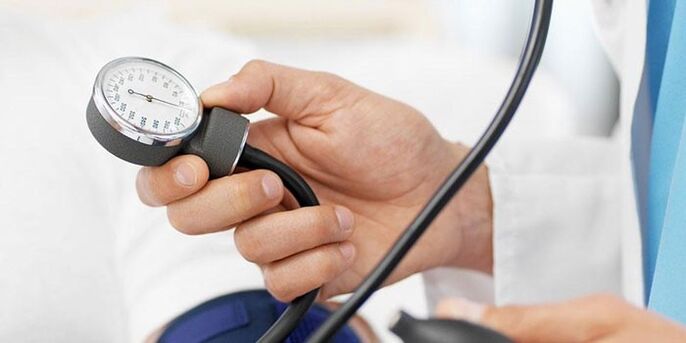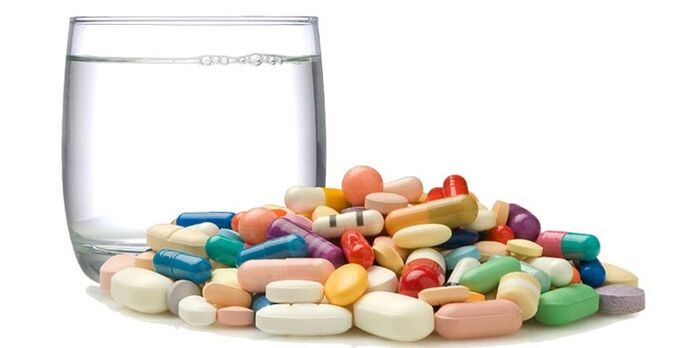Hypertension is the most common cardiovascular disease, the symptoms of which after 60-65 years of age affect a large part of the population. The diagnosis has several names, including essential hypertension (AH), arterial hypertension (AH). The disease is chronic, the main task of each patient is to avoid exacerbations and prolong the period of remission (disappearance of symptoms) with the help of medical and non-medical methods.
What is hypertension
Hypertension is a constant increase in blood pressure above an acceptable level (starting from 140/90 mm Hg) under the influence of provoking factors. This diagnosis is called a "silent killer. "The pathological process takes a long time in asymptomatic form, but during the attack significantly increases the risk of stroke, myocardial infarction and other dangerous diseases. The potential complications of GB can be life-threatening, so the disease needs timely diagnosis and adequate treatment.
Hypertension develops as a result of dysfunction of the higher centers of neurohumoral regulation, kidneys, blood vessels. In the absence of timely treatment, the pathological process leads to organic and functional disorders of the heart, central nervous system and kidneys. Improperly chosen therapy can lead to disease progression with increased pain.
Classification of hypertension
In 2003, a uniform classification of hypertension according to the severity of the disease was determined. The determining factor in this division is considered to be the actual blood pressure reading determined by the tonometer in a particular clinical case. Hypertension is also classified by origin (primary, secondary), stages (transient, stable, sclerotic) and level of risk of cardiovascular pathology. This classification simplifies the diagnosis, helps to more accurately determine the treatment regimen for each patient with hypertension.

Degrees of arterial hypertension
With an increase in blood pressure (BP), it is suspected that hypertension is progressing, especially if it is not possible to solve this health problem with non-drug methods. It is important to know that the optimal blood pressure is 120/80 mm Hg. Art. , normal - 120-129 mm Hg. Art. (systolic pressure - SBP) and 80-84 mm Hg. Art. (diastolic - DBP), high normal - 130-139 mm. rt. Art. (SAD) and 85-89 mm. rt. Art. (father). Deviation from these figures indicates serious pathologies of the body. Doctors distinguish 3 degrees of GB:
- Grade 1 (mild) hypertension is characterized by unstable pressure that ranges from 140/90 to 159/99 mm Hg for several days. Art. The risk of developing a hypertensive crisis is minimal, there are no symptoms of organic damage to internal organs and the central nervous system. To suppress a painful attack, in addition to taking medication, the patient needs a good rest, excluding stressful situations. Positive emotions, walks in the fresh air are especially useful.
- Grade 2 hypertension develops rapidly. The blood pressure index varies from 160/100 to 179/109 mm Hg. Art. , there are symptoms of hypertensive crisis (cold sweats, goosebumps, flushing). The patient is concerned about migraine attacks, dizziness, poor sleep, shortness of breath. Clinical manifestations of hypertension: transient cerebral ischemia (decreased blood flow to the organ), increased creatinine in the blood, narrowing of the retinal arteries, hypertrophy (increase in size) of the left ventricle, microalbuminuria (detection of protein in urine analysis). It is not possible to normalize the condition without medication.
- Grade 3 hypertension (severe) is accompanied by a sharp decrease in visual acuity, poor memory, tachycardia (increased heart rate). A hypertensive crisis develops. Indicator of blood pressure - from 180/110 mm Hg. Art. and higher. Possible complications include hypertensive encephalopathy, cerebrovascular thrombosis and aneurysm (pathological vasodilation), left ventricular heart and kidney failure, hemorrhage (bruising) and swelling of the optic nerve. The pathological changes are irreversible.
Degree of cardiovascular risk
To predict the likelihood of complications in progressive hypertension, the first step is to determine the cardiovascular risk index. This requires expert advice, complex diagnostics. The degree of hypertension provoking relapse (physiological and pathological) is reported. Common risk factors are:
- smoking, other bad habits;
- high blood cholesterol;
- sedentary way of life;
- obesity, including abdominal (most of the fat is deposited in the abdomen);
- age (women over 65, men over 55);
- fasting sugar index 5, 6-7, 0 mmol / l;
- impaired glucose tolerance determined by a special test;
- the presence of diseases of the cardiovascular system in relatives;
- male gender.
The patient has a high degree of cardiovascular risk if, in addition to hypertension, there are concomitant chronic diseases:
- diabetes;
- heart failure;
- disorder of lipid (fat) metabolism;
- bronchial asthma;
- extensive retinal damage;
- coronary artery disease;
- stage 4 renal failure;
- suffered a stroke;
- cerebrovascular diseases (damage to the vessels of the brain);
- signs of obliterating diseases of the peripheral arteries of the lower extremities (atherosclerosis);
- damage to other internal organs.

Such information helps the doctor to predict the clinical outcome of the disease. To determine the cardiovascular risk indicator for each degree of hypertension, you should read the table below:
> zxtable border = "1" cellpadding = "0" >Treatment of hypertension
The classification of GB according to stages and risks helps to correctly determine the regimen of drug therapy, rapid cessation of the painful attack and prolong the period of remission. If primary arterial hypertension (isolated) develops, following medical recommendations, the prognosis is favorable. The secondary form of the disease often has complications.
If the disease is not cured in time, high blood pressure is difficult to stabilize even with medication. The general recommendations of specialists, if hypertension of 1, 2 or 3 degrees is diagnosed, are presented below. . It should be supplemented with medication prescribed by your doctor:
- Adherence to a therapeutic diet. It is important to reduce portions of salt, to enrich the daily diet with foods with potassium and magnesium to strengthen the heart muscle (seeds, nuts, legumes and cereals, vegetables).
- Rejection of bad habits. This applies not only to drinking and smoking, but also to the need to increase physical activity, abandon the "sedentary" lifestyle and walks in the fresh air.
- Weight control. If the patient with hypertension is obese, it is necessary to give up fatty, fried and smoked foods and regularly organize fasting days.
- Physiotherapy. To prevent and prolong the remission period of GB, it is recommended to perform moderately intense exercise for 30 minutes 5 times a week.
- Taking multivitamin complexes. The composition of such drugs should contain potassium, magnesium, iron and other important trace elements.

Medical therapy
Oral medications depend on the degree of hypertension and the symptoms associated with it. The following are the optimal regimens for conservative treatment of hypertension:
- In the mild stage of the disease, the patient is prescribed angiotensin-converting enzyme inhibitors, angiotensin receptor antagonists, calcium channel blockers.
- The development of grade 2 hypertension requires an integrated approach to the problem, which combines several representatives of different pharmacological groups in one conservative treatment regimen. These are the above drugs in combination with thiazide diuretics.
- In the complicated course of this disease, in addition to the above medications, doctors recommend alpha- or beta-blockers. The need arises if high doses of diuretics are poorly tolerated by the weakened body).





















